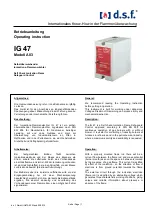
Operation using IEEE-488 Programming
This section covers basic operation only. For detailed information on pulse loading with
the IEEE-488 commands, refer to the
IEEE-488 Commands and Programming
section
and the
Language Elements
Chapter 3 later in this manual.
Effects of Cable Inductance On Pulse Loading
When the Dynaload is used for high current pulse loading, the effects of cable inductance must
be considered. The critical parameters are the rise time of the current and the minimum
compliance voltage specifications. If the inductance of the cables from the voltage source is
great enough to cause the voltage at the Dynaload to go below the minimum compliance level,
then excessive current wave form distortion will occur. This is the result of the power devices
driving into saturation. They attempt to reach the programmed current, however they cannot
because of the low drain voltage. Once in a saturated state, the response time is much slower.
The result is a significant overshoot on the rising edge of the pulse.
In order to prevent this from occurring, it should be noted that:
1 microhenry = 2.4 feet of wire (total)
50A @ 50 microseconds rise time = 1 volt drop with 1 microhenry
The inductive drop cannot exceed the difference between the source voltage and the minimum
compliance.
EXAMPLE:
Referring to Equation 1 that follows, to test a 10V source with a 100A pulse, and
assuming a 3 Volt minimum compliance, the maximum cable length would be:
Equation 1. Establishing Maximum Cable Length
In the example above, the maximum cable length is equal to 8.4 feet total or 4.2 feet per cable
from the source to the Dynaload.
If the distance from the load to the source must be greater than this, there are several methods to
increase the maximum distance. One way is to use several “Twisted Pair” insulated conductors.
This cuts the inductance in half if 4 are used instead of 2, or by 1/3 if 6 are used. This double or
triples the maximum length, respectively.
Another method is to slow down the rise time of the pulse generator before applying it to the
regulation loop. Increasing the slew rate to 100 microseconds will double the maximum cable
length.
The third method is to use a large electrolytic capacitor at the Dynaload input terminals that can
supply current necessary to counteract the inductive drop of the cable.
Page 32 Of 162
E Max drop = 7V
L = 3.5 microhenries maximum
E = L
7V = L
402825-02-12.CDR
di
dt
100A
50µs
















































